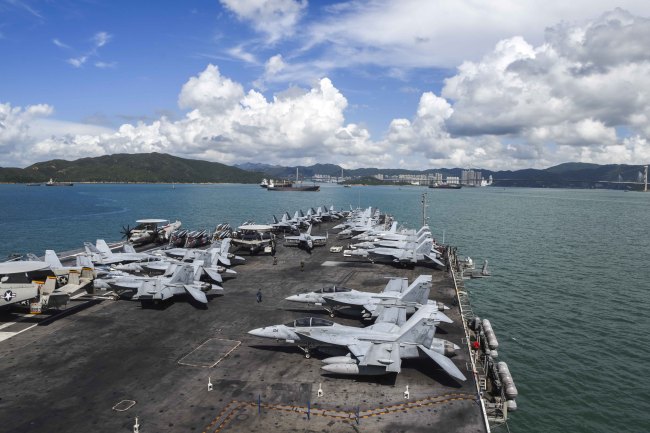Tension runs high ahead of allies’ joint military drill
By Yeo Jun-sukPublished : Oct. 15, 2017 - 18:06
With South Korea and the US militaries staging a joint naval drill this week, tension is expected to heighten on the Korean Peninsula amid worries that North Korea might carry out another provocation to protest against the show of force.
Starting from Monday, the allies kick off a five-day joint naval exercise in the waters east and west of the peninsula. The exercise involves nuclear-powered aircraft carrier USS Ronald Reagan and its carrier strike group.
North Korea, which has renewed the threats to launch a ballistic missile toward US territory of Guam, has been spotted on various locations operating mobile launchers for ballistic missiles, according to the South Korean military.
“Transporter-rector-launchers have appeared and disappeared repeatedly on multiple locations in North Korea,” a Seoul military official said Sunday under the customary condition of anonymity. “We assess they can carry out provocation anytime and therefore maintain enhanced surveillance.”
North Korea has accused the joint drill as being a dress rehearsal for invasion even as the allies’ insisted that it was defensive in nature. The allies’ militaries will participate in the Maritime Counter Special Operation, which is designed to defend the infiltration of North Korea’s special warfare forces.

Since its nuclear test on Sept. 15 and following its ballistic missile launch, North Korea has not conducted major provocations despite rampant speculation that the regime could do it on and around Oct. 10, when the regime celebrated the founding day of its ruling Korea Workers’ Party.
But the military officials and analysts suspect that the communist country would break its weekslong hiatus “anytime soon” as the regime seeks to show full-fledged nuclear capability threatening enough to coerce the US and its allies.
“The final remaining card for North Korea is to show the world that it has perfected nuclear capability,” said Kim Dong-yup, a professor at Kyungnam University’s Far East Institute “They have appeared to put the final touches on it to avoid failure.”
North Korea has showcased its ability to send its ballistic missile to the contiguous US through a series of successful tests in July, but whether the regime has secured technology to protect nuclear warheads during the re-entry phase is in doubt.
Some analysts suggested that North Korea might have been looking for the perfect time to maximize its impact of provocation, this time around when China holds the 19th National Congress of the Communist Party on Oct 18.
Thought to be a main ally and economic supporter of North Korea, China has implemented a series of measures designed to restrict its trade with the North after the United Nations adopted sanctions over the North’s missile and nuclear tests.
“Based on its military and political calculation, North Korea will determine when to carry out provocations,” said Shin Bum-cheol, a professor at Korea National Diplomatic Academy. “We don’t have to consume ourselves with the timings.”
However unlikely, if North Korea eventually refrained itself from provocation until next month when US President Trump is slated to visit South Korea and other countries in the region, it would help create momentum for negotiation, analysts said.
Following a series of ambiguous threats to North Korea, US President Donald Trump said Friday that the US is “always open” to negotiations, signaling a shift in tone from his recent comments disparaging the chances of successful talks with Pyongyang.
A day earlier, White House Chief of Staff John Kelly said while the US would never allow for the North to develop the ability to strike the US, the regime’s missile threat is “manageable” for now. He also expressed hopes that the diplomacy would work before the regime grows its missile capability.
“This year North Korea has conducted missile tests immediately after when there was progress on technology,” said Koh Yoo-hwan, a professor of North Korean studies at Dongguk University. “Whether the North would conduct further provocations depends on how the US and North Korea play their games.”
The scheduled military exercise comes as the US has sent a batch of its strategic assets, including nuclear submarine USS Michigan, which arrived at the southern port of Busan on Friday. Armed with Tomahawk tactical missiles, the submarine is thought to be capable of striking North Korea‘s core missile facilities.
A group of stealth fighters and US bombers will also be dispatched to attend the biennial military exhibition held in Seoul. A B-1B Lancer and a F-22 Raptor will be displayed during the International Aerospace and Defense Exhibition. It will kick off on Tuesday.
By Yeo Jun-suk (jasonyeo@heraldcorp.com)




![[KH Explains] No more 'Michael' at Kakao Games](http://res.heraldm.com/phpwas/restmb_idxmake.php?idx=644&simg=/content/image/2024/04/28/20240428050183_0.jpg&u=20240428180321)












![[Herald Interview] Mistakes turn into blessings in street performance, director says](http://res.heraldm.com/phpwas/restmb_idxmake.php?idx=652&simg=/content/image/2024/04/28/20240428050150_0.jpg&u=20240428174656)
